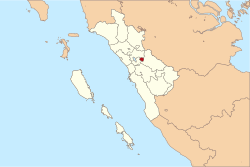Sawahlunto | |
|---|---|
| City of Sawahlunto Kota Sawahlunto | |
| Other transcription(s) | |
| • Jawi | ساواهلونتو |
 Bukit Asam Office, a notable landamark of Sawahlunto | |
 Location within West Sumatra | |
| Coordinates: 0°40′S 100°47′E / 0.667°S 100.783°E | |
| Country | |
| Region | Sumatra |
| Province | |
| City Established | 1 December 1888 |
| Government | |
| • Mayor | Deri Asta |
| • Vice Mayor | Zohirin Sayuti |
| Area | |
| • Total | 273.45 km2 (105.58 sq mi) |
| Population (mid 2023 estimate) | |
| • Total | 67,760 |
| • Density | 250/km2 (640/sq mi) |
| [1] | |
| Time zone | UTC+7 (Indonesia Western Time) |
| Area code | (+62) 754 |
| Climate | Af |
| Website | sawahluntokota.go.id |
Sawahlunto (Jawi: ساواهلونتو) is a city in West Sumatra, Indonesia. It lies 90 kilometres (a 2-hour drive) from Padang, the provincial capital. Sawahlunto is known as the site for the oldest coal mining site in Southeast Asia. Sawahlunto is geographically located in a narrow valley along the Bukit Barisan mountains and surrounded by several hills, namely Bukit Polan, Bukit Pari, and Bukit Mato.[2] The town has a land area of 273.45 sq. km, and had a population of 56,866 at the 2010 Census,[3] 60,136 at the 2015 Census, and 65,138 at the 2020 Census;[4] the official estimate as at mid-2023 was 67,760 - comprising 34,090 males and 33,670 females.[1]
Sawahlunto is one of the mining towns in West Sumatra. It was first established as a town in 1882 by the Dutch along with coal mining operations. Coal was discovered in the mid-19th century by Ir. de Greve. It was then suggested to the Dutch that coal should be mined in the area because coal was needed for industry and transportation. After the discovery of coal, the area was frequently visited by geologists. Coal mining was pioneered in the area after the eventual "surrender" of the area to the Dutch in 1876. After the golden period of mining and the closure of the mine sites, Sawahlunto became a ghost town and the population declined. In 2004, the city's policy became to turn Sawahlunto into a tourist city, since when the population has increased. In 2014, 29 percent of its income came from tourism, while only 23 percent came from farming.[5]
The Ombilin coal mining site at Sawahlunto has been listed as a UNESCO World Heritage Site in 2019.[6]
- ^ a b Badan Pusat Statistik, Jakarta, 28 February 2024, Kota Sawahlunto Dalam Angka 2024 (Katalog-BPS 1102001.1373)
- ^ "8 Fakta Tambang Batubara Ombilin Sawahlunto yang Baru Jadi Warisan Dunia". Kompas. Retrieved 8 July 2019.
- ^ Biro Pusat Statistik, Jakarta, 2011.
- ^ Badan Pusat Statistik, Jakarta, 2021.
- ^ Hans david Tampubolon (5 September 2014). "Sawahlunto: A small town that dreams big".
- ^ "Govt Urged to Stop Mining Activities in Sawahlunto". Tempo. Retrieved 8 July 2019.


